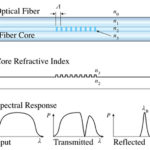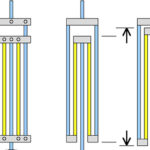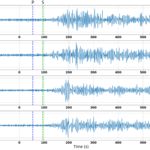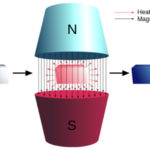Among the many ways to sense temperature, combinations of advanced optical principles used with optical fibers offer very different approaches, with application advantages and implementation limitations.
The previous part of this article looked at two approaches to using optical fibers for temperature sensing based on the fiber Bragg grating (FBG) and the Mach-Zehnder interferometer (MZI). Other sophisticated electro-optical techniques are being investigated, with some in modest “field” use. Among these are:
Other fiber-based approaches are also being investigated and, in some cases, used in research or industrial settings to some extent. Among them:
- The Fabry-Pérot interferometer (1897): This uses a pair of an interferometer based on two highly reflective mirrors facing each other to form a standing-wave cavity resonator, with a mirror-spacing distance on the order of just 50 μm (Figure 1). This micro-spacing is affected by the temperature being measured via thermal expansion of the material, and therefore the peak-transmission wavelength can indicate the temperature. Since the probe light and the reflected light can be sent through a single fiber, and the fiber is only used for transporting the light but not for the actual sensor, this is called an extrinsic fiber sensor (in contrast to intrinsic sensors where the fiber itself acts as a sensor).
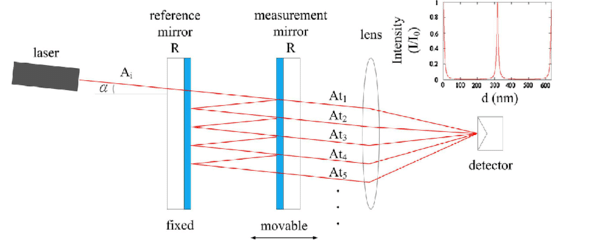
These micro-sized Fabry–Pérot interferometers can be constructed in different ways, such as by maintaining an air gap between two fiber ends with some mechanical fixture, or by using two fusion splices (a low-loss joining of two fiber ends) which are made reflective by applying dielectric coatings to the fiber ends.
- Rayleigh scattering: this is the scattering of light at scattering centers which are much smaller than the wavelength due to microscopic variations in the fiber. This results in fluctuations of the fiber’s refractive index, and these variations change with temperature. This is a very weak effect, so it is a very different phenomena to exploit.
- Raman scattering and Raman spectroscopy are widely used techniques for materials analysis (including looking inside a sealed package or enclosure). Energy is pumped into the substance under assessment. The system looks at the wavelengths given off – called back scatter – as the constituent atoms relax back to their unenergized resting state. As the temperature varies, the energy levels of this back scatter change as well, characterized by a complex but definitive equation.
A Raman-scattering temperature-sensor system can work with long lengths of fibers, even tens of kilometers. The system needs to measure the powers of wavelength components just above and just below the pump wavelength (corresponding to few tens of nanometers of wavelength) to determine the power ratio of incident to returned energies. The spatial resolution is on the order of 1 meter. The temperature resolution can be of the order of 1 K, which is well suited for monitoring oil and gas pipelines.
- Brillouin scattering: this is a nonlinear scattering phenomena which uses the temperature dependence of the refractive index and the velocity of sound, which together determine the magnitude of the Brillouin frequency shift of acoustic phonons. [A phonon is not a photon: a photon is a form of energy, but the phonon is a mode of oscillation that occurs in lattice structures. A photon can be considered as a wave and a particle, which are physically observable entities. A phonon is a mode of vibration, which is neither a wave nor a particle. ]
In stimulated Brillouin scattering and Brillouin optical time delay analysis (BOTDA), picosecond optical pulses are injected into a fiber. Another weak continuous-wave probe beam is also injected but in the opposite direction to the picosecond pulses. The probe beam is then amplified at locations where the optical frequency difference between the pulses and the probe beam coincides with the local Brillouin shift, a function of the fiber strain and temperature. Using a variable optical-frequency difference, it is possible to create a map of the Brillouin frequency and thus temperature versus position.
If Rayleigh, Raman, and Brillouin scattering seem esoteric – well, they are. In quick summary: the light backscattered by an optical fiber segment without any defects or abnormal characteristics can be spectrally decomposed into three distinct peaks corresponding to three phenomena (Figure 2):
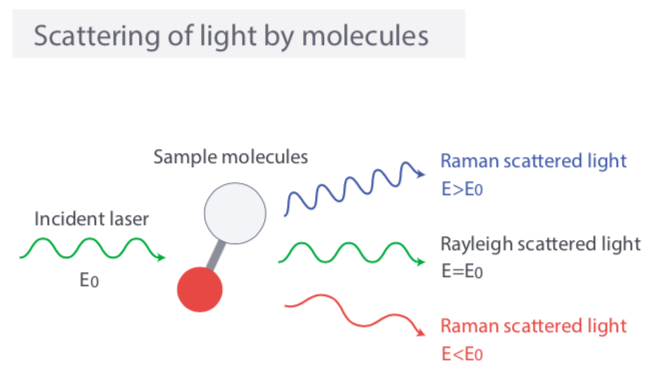
- Rayleigh scattering: The electromagnetic wave propagating in the fiber core interacts with the scattering centers, silica impurities, and enhancing additives.
- Raman Scattering: The Raman effect is an interaction between light and thermal vibration of silica molecules and is highly dependent on the temperature at the spectral level.
- Brillouin Scattering: The Brillouin effect originates from photon-acoustic phonon interaction. It generates light with a frequency shift of approximately 10 GHz compared to the incident light.
If the emitted photon has more energy than the absorbed photon, the energy difference is called an anti-Stokes shift; when the emitted photon has less energy than the absorbed photon, this energy difference is called a Stokes shift.
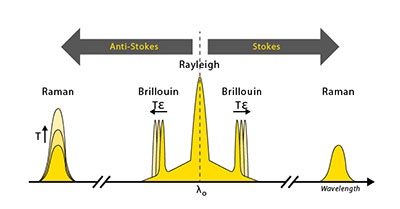
Pros and cons of fiber-optic based temperature sensing
As with any technology resource, there are advantages and drawbacks to fiber-optic temperature sensing. In broad terms, on the “plus” side:
- It is highly immune to nearby EM (electromagnetic) and even nuclear radiation.
- As it is non-electronic at the sensing end, it can be used where intrinsic safety considerations apply.
- The fiber itself is lightweight, flexible, and compact.
- The fiber is rugged and can withstand temperature and harsh surroundings, such as deep-drilling well holes.
- The fiber sensor can be located at a distance from the electronics.
- Standard, commercial fiber-optic sensors are available for some of these approaches
However, there are drawbacks:
- These are sophisticated, advanced approaches, and matching the technique to the application can be difficult.
- The system needs lasers for optical sources and advanced optical-measurement instrumentation such as spectrum analyzers.
- It can be complicated to develop measurement systems using fiber-optic sensors, and advanced user training is needed.
- The underlying physics principles are also complex, sophisticated, and admittedly difficult to understand; this can lead to implementation difficulties, troubleshooting issues, and a lack of confidence in the measurements.
- Assessing system-level accuracy can be a challenge.
- Although the fiber is not expensive, the overall system with lasers and spectrum analyzers can be large and costly.
Taking optical fiber beyond temperature sensing
Although this article has focused on optical fibers for temperature sensing, their use is not limited solely to that admittedly vital physical parameter. They are already being used in real-world settings to sense and measure microbending in large structures, including the use of Brillouin scattering as a distributed strain sensor (Figure 4).
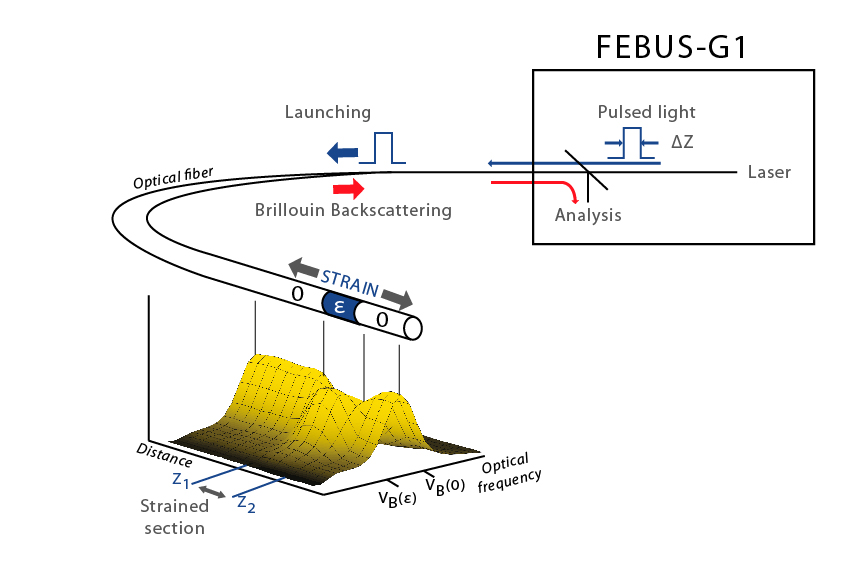
There are also many research projects and highly advanced projects investigating the use of these fibers and integrated electro-optics, and other photonic components to sense other physical including micro-and gross-scale magnetic fields, as another example.
Related EE World Content
- Undersea optical-fiber cables do double-duty as seismic sensors, Part 1: Context
- Undersea optical-fiber cables do double-duty as seismic sensors, Part 2: Application
- Optical amplifiers, Part 1: Applications and considerations
- Optical amplifiers, Part 2: Basic implementations
- Wheatstone bridge, Part 1: Principles and basic applications
- Wheatstone bridge, Part 2: Additional considerations
- Gyroscopes, Part 2: Optical and MEMS implementations
- What are cryogenic temperature measurements? Part 1
- What are cryogenic temperature measurements? Part 2
- Fiber Optic Sensor Measures Tiny Magnetic Fields
External References
Temperature Sensing
- RP Photonics Consulting GmbH, “Optical Temperature Sensors”
- Opsens Solutions, “Fiber Optic Temperature Sensors”
- Micronor LLC, “TS Series Temperature Sensors”
- Micronor LLC, “Why Fiber Optic Sensing?”
- Wikipedia, “Fiber-optical thermometer”
- InTechOpen, “Optic-Fiber Temperature Sensor”
- RF Wireless World, “Fiber Optic Temperature Sensor structure, working, advantages, disadvantages”
- RP Photonics, “Optical Temperature Sensors”
- Research Gate, “Applications of fibre optic temperature measurement”
- Sensor Letters, “A New Fiber Optical Thermometer and its Application for Process Control in Strong Electric, Magnetic, and Electromagnetic Fields”
- Research Gate, “Ultra-high Sensitive Temperature Sensor Based on Multimode Fiber Mach-Zehnder Interferometer”
Scattering
- Wikipedia, “Brillouin scattering”
- Washington University/St. Louis, “What is Raman scattering?”
- Georgia State University, “Raman scattering”
- BW Tech, “Theory of Raman Scattering”
- Nano Photon, “What is Raman spectrum?”
- RP Photonics, “Rayleigh Scattering”
Background and Related
- Wikipedia, “Fiber Bragg Grating”
- Laser Focus World, “Distributed fiber-optic hydrophone is based on heterodyne coherent detection”
- Laser Focus World, “Fiber-optic communications: Tailoring the fiber to the task”
- Wikipedia, “Michelson–Morley experiment”
- NASA, “Sensing Magnetic Fields: Using an Innovative Optical Waveguide Fiber Bragg Grating”
- OSA Publishing, “All-fiber-optic vector magnetic field sensor based on side-polished fiber and magnetic fluid”
- Photonics, “LIGO Continues Making Waves”
- The Optical Society, “LIGO-Virgo in OPN”

